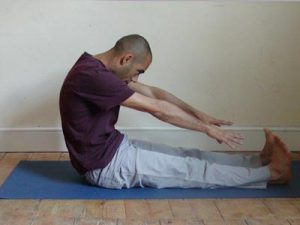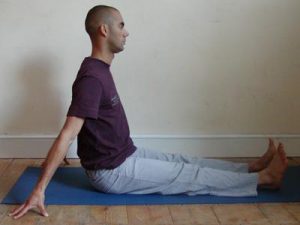Following on from part one, here are some instructions on stretching techniques:
How to Stretch
- Move slowly into each position until you feel a mild stretch in the target muscle.
- Only go as far as feels comfortable & stable for you at that time.
- Breathe & relax. Allow the mind to calm.
- Maintain the position & feel the stretch.
- Pay attention to which muscles are tight & resisting the stretch. Allow these muscles to ‘let go’.
- Be sure you feel the stretch in the ‘belly’ of the target muscle.
- Once the muscles release you can take the stretch a little further until you feel a mild stretch again.
- Maintain this position. Again be aware of which muscles tighten up.
- Breathe & relax. Try to keep the mind calm.
- Hold each stretch for 15 to 20 seconds or 3 or 4 even breaths.
Things to be aware of when stretching
- You are aiming to develop elasticity in the muscles NOT in the tendons or ligaments (where the muscles attach to the bones) as this may cause injury.
- Don’t force a stretch, this creates tension in the muscles. Your muscles have a stretch reflex which effectively tightens (shortens) the muscles to prevent them from over stretching. By moving into a mild stretch & allowing the muscles to relax you can overcome this reflex & then take the stretch a little further thus developing flexibility.
- Try to maintain length in your spine – from the base of your pelvis out through the top of your head – & pay attention to the alignment of your joints.
- Keep within your limits – you’re not competing. If you find a particular stretch uncomfortable, find a milder variation until you become more supple.
- Allow your body & mind to adapt over time through regular daily practice.
To find out more about stretching I can highly recommend Extension by Sam Dworkis (link takes you to Amazon). This book gives detailed descriptions of how to align your body & create effective stretches using yoga postures.
Seated hamstring stretch – poor
-
 I’m focused on touching my toes – forcing the stretch.
I’m focused on touching my toes – forcing the stretch. - I’m sitting on the back of my pelvis which directs my lower back out behind me (throwing me off balance).
- To compensate I’m forced to bring my head forward & crunch my stomach, arching my back.
- I’m stretching muscles in my back & not lengthening the hamstrings (back of thighs) which are the target muscles in this stretch.
Seated hamstring stretch – better
- I’m sitting on the sitting bones at the base of my pelvis.

- The pelvis rotates forward & sends the spine upwards.
- My head can now balance on top of my spine.
- By rotating forward at the hips I’m lengthening between the knees & the base of the pelvis thereby targeting the stretch in the hamstrings.
- My stomach is more open making it easier to breath.